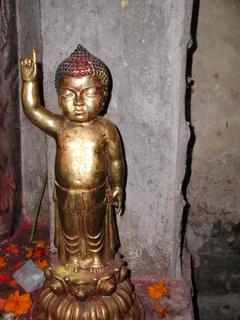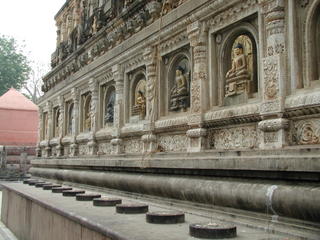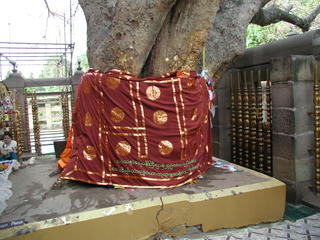

Sarnath (Isipatana), Deer Park,
the Site of the Buddha’s First Discourse
I. Location and Significance
Sarnath, also previously known as Mrigadava, Rishipattana, and Isipatana, located about six miles from Varanasi (Baranasi, Benares) in Uttar Pradesh, India, is the deer park where the Buddha delivered the first discourse, set in motion the wheel of the Dhamma, and founded the Sangha. Sarnath (cf. Saranganath) means lord of the deer; Mrigadava means deer park; and Rishipattana and Isipatana mean the place where the holy men fell to earth when devas announced to them the birth of the future Buddha (cf. Pali, isi, holy men; and Sanskrit, rishi). The Buddha subsequently converted Yasa, the son of a wealthy nobleman of Varanasi, as well as his family and friends. A short time afterwards Yasa and the others became monks at Sarnath. The following rainy season the Buddha stayed at the monastery at Sarnath. By this time the Sangha had grown to sixty monks. The Buddha sent them out to preach the Dhamma. The Buddha later preached other important discourses at Sarnath. By the seventh century when the Chinese traveler Hsuan Tsang visited Sarnath, there were thirty monasteries and three thousand monks there. The site became an important center for one of the Theravada schools. It was plundered and burned by the end of the 1100s by Turkish Muslims. There followed the diaspora of the Sangha, and the site was then forgotten for about seven hundred years. Sarnath was rediscovered about 1800, and excavations began. The site is the location of several monuments important to the history of Buddhism, including the Dhammarajika stupa, built by King Asoka, as well as the Asokan pillar with its lion capital.
II. The Story of the Buddha’s First Discourse
Sarnath was the location of the Buddha’s first discourse. The Buddha had achieved Enlightenment at Uruvela (presently Bodh Gaya) under the bodhi tree on the banks of the Neranjara after repulsing the attempts of Mara, the evil tempter, to prevent him from reaching Buddhahood. After reaching Enlightenment, the Buddha spent seven days at Uruvela and seven days at six other nearby locations, a total of forty-nine days, enjoying the bliss of sainthood. He thought about giving his first discourse to Alara Kalama, a wise man who would quickly acknowledge the truth of the Dhamma. However, a deity came to the Buddha to tell him that Alara Kalama had died a week earlier. Then he thought about giving his discourse to Uddaka, student of the wise man Rama. However, once again a deity came, this time to announce that Uddaka had died the night before (cf. the “Mahapadana Sutta: The Great Discourse on the Lineage,” in The Long Discourses of the Buddha (Digha Nikaya), II:40, 3.8ff., the story of Khanda and Tissa, an alternate version.) At this point the Buddha recalled the five bhikkhus, Kondanna, Vappa, Assaji, Mahanama, and Bhaddiya, the Pancavaggiya, with whom he had practiced the ascetic life for six years before realizing that it was not conducive to liberation. He wanted to pay them back for the help they had given to him. So he set off on foot for Sarnath, the deer park at Varanasi, about 142 miles away, where the five were staying.
The Buddha had traveled only a short distance when he met the naked ascetic Upaka, a follower of Nataputta of the naked sect. He attempted to convince the man of the truth of Buddhism but was unable to do so because of the ascetic’s misconceptions. When the Buddha had arrived at Sarnath and had approached the five bhikkhus, they decided they would ignore him and not pay him honor. However, when the Buddha came near they lost their resolve because they were so impressed by the glory and serenity of his countenance. They greeted him and called him “friend,” prepared a seat for him, and washed his feet. The Buddha told the five ascetics that he was the fully Enlightened One and that he would teach them the truth of the Dhamma. He said that if they practiced the Dhamma, as instructed by him, they would achieve Nibbana, Enlightenment. For a time the five remained incredulous, but after a while, realizing he had never made such claims in the past, they became receptive to his words.
So at Sarnath, the deer park near Varanasi, the Buddha delivered to the Pancavaggiya his first discourse, the Dhammacakkappavattana Sutta, “Setting in Motion the Wheel of the Dhamma” (cf. The Connected Discourses of the Buddha (Samyutta Nikaya), 56:11; cf. the analysis in the “Saccavibhanga Sutta; The Exposition of the Truths,” Number 141 in The Middle Length Discourses of the Buddha (Majjhima Nikaya), also delivered at Sarnath; and in the Vibhanga, 99-105, in the Abhidhamma Pitaka). The first discourse was concerned with the Middle Way and the Four Noble Truths. The Buddha first spoke about the Middle Way--the way leading to Enlightenment—which lies between the extremes of sensual gratification, on the one hand, and of the self-mortification of the ascetic life, on the other. The Middle Way, as described in the discourse, is the Eightfold Path that includes right view, right thought, right speech, right action, right livelihood, right effort, right mindfulness, and right concentration. The Four Noble Truths are the truths of suffering (in brief, the five aggregates), of the origin of suffering (craving), of the cessation of suffering (freedom from craving), and of the way leading to the cessation of suffering (the Eightfold Path, the Middle Way). Hearing the Buddha’s words, the five ascetics became convinced of the truth of what he said. The conversion of the five bhikkhus represented the beginning of the Sangha, the order of the Buddhist monks. The words of the Buddha also set in motion the wheel of the Dhamma, the wheel symbolizing the eternal cycle of the existence of the world (samsara), the endless life after life of craving. (Cf. the “Ariyapariyesana Sutta; The Noble Search,” Number 26 in The Middle Length Discourses (Majjhima Nikaya), 13-30, where the Buddha recounts to the bhikkhus the story of his search for Enlightenment from his early experiences with the ascetics to his conversion of the five at Deer Park. Cf. Number 36, the “Mahasaccaka Sutta; The Great Discourse to Saccaka,” Middle Length Discourses. Sections 13 through 16 of this sutta repeat sections 14-17 of Numbe 26 in a new setting. Cf. Dhammacakkapavattana Sutta; The Great Discourse on the Wheel of Dhamma, by Ven. Mahasi Sayadaw, pp. 44-63, an account of the Buddha’s story from the Enlightenment to the first discourse at Deer Park which, relying on the Commentaries, never mentions, curiously enough, the more pertinent suttas in the Majjhima Nikaya.)
III. Archeology and Monuments
Sarnath is the site of many important Buddhist monuments, the most notable being the Dhammarajika stupa, the Dhamek (Dharmek, Dhammeka) stupa, the Mulagandhakuti (the main shrine), the Asokan pillar and lion capital, and the preaching Buddha statue. (Cf. Sarnath: The Great Holy Place of Buddhists, by Shanti Swaroop Bauddh, translated by Moses Michael, the principle text used in the following discussion; and Middle Land, Middle Way; A Pilgrim’s Guide to the Buddha’s India, by Ven. S. Dhammika, pp. 73-87.)
1) The Dhammarajika stupa, built by Great King Asoka, who visited Sarnath in 249 B.C., originally contained relics presumed to be those of the Buddha. Before six subsequent enlargements were made to it, the stupa had been about forty-four feet in diameter. Today only the foundation remains. Tragically enough, in 1794 Jagat Singh, a Varanasi minister, dismantled the stupa so he could use the red bricks for building a housing project. The relics were found about twenty-seven feet from the top in a small green marble casket inside a stone box. In accordance with the Hindu custom of the time, the remains were thrown into the Ganges River. The Commissioner of Varanasi, Jonathan Duncan, published a report on the finding of the relics as well as of a Buddha statue in the stupa. Interest in Sarnath soon grew. In 1815 the archeologist Colonel C. Mackenzie started exploration of the ruins and surveyed the area. From late 1834 to1836 Alexander Cunningham conducted systematic excavations at Sarnath and explored not only of the Dhammarajika stupa but also the Dhamek stupa, the Coukhandi stupa, and a vihara and a temple near the Dhamek stupa.
2) The Dhamek stupa, the impressive cylindrical structure that exists at Sarnath today and dates from the early sixth century A.D., measures ninety-three and a half feet in diameter and one hundred thirty-eight feet high, including the foundation. Asoka built the original stupa at this location. The remains of this original are what Cunningham probably found when he bore a shaft in the center of the Dhamek stupa and found remnants of a Mauryan-brick structure. There were no relics inside. However, Cunningham did find a stone slab with an inscription in sixth-seventh century script suggesting a connection with the Dhamma. The inscription of King Mahipala (1026 A.D.) indicates that the original name of the stupa was the Dhammacakka (Sanskrit, Dharma Chakra) stupa (“stupa of the turning the wheel of the law”). This evidence suggests that the Dhamek stupa was the exact location of the Buddha’s first discourse, the Dhammacakkappavattana Sutta. Portions of the bottom of the stupa are covered with a wide band consisting of a pattern of swastikas (fylfots) with a lotus wreath at the top and bottom. At the bottom of the stupa eight large shelves, spaced at equal distances around the circumference, are built into the wall. These apparently once contained images of the Buddha.
3) The ruins of the Mulagandhakuti (main shrine, a vihara), or the First Perfumed Chamber, lie to the north of the Dhammarajika stupa (perfumed in the sense of incensed). (There is another shrine at Sarnath, the sunken shrine of Pancayatana, east of the Dhammarajika stupa under a sunken concrete platform.) The Buddha stayed at the Mulagandhakuti during the first rainy season following the first discourse. A rich man named Nandiya donated it to the Buddha. The shrine was a square building with the entrance to the east, each side about sixty feet long; according to Hsuan Tsang, it was about two hundred feet high. The area between the shrine and the Dhammarajika stupa is believed to have been the Camkama, the promenade where the Buddha performed his walking meditation.
4) To the west of the Mulagandhakuti are the remains of the Asoka pillar, discovered in 1904. Originally about forty-nine feet high surmounted by a capital, the remaining base today is about six and a half feet high. The monolithic shaft was slightly tapered, about twenty-eight inches in circumference at the bottom, about twenty-two inches at the top. The pillar’s brownish-sandstone capital, now located in the Sarnath museum, depicts the fronts of four lions, each head facing a different direction. (The lion capital is the official emblem of modern India.) The abacus contains four animals: an elephant (Buddha at conception), a bull (Buddha’s birth sign), a horse (his renunciation of home life), and a lion (his first discourse). A large Dhammacakka (“wheel of the law”) with thirty-two spokes presumably topped the capital of the original Asoka pillar. There were three inscriptions on the pillar, the oldest an edict from Asoka in Brahmi warning monks and nuns against schism in the Sangha. The site of the Asoka pillar is believed to be the place where the Buddha assembled the first sixty bhikkhus and directed them to go out and spread the Dhamma.
5) During the Gupta age, roughly from the fourth century to the sixth century A.D., the same age that saw the creation of the Ajanta caves, Sarnath became a center of Buddhist art. The beautiful carving of the preaching Buddha, the Dhammacakkappavattana statue, currently in the Sarnath museum, bears witness to this fact. It was a gift of King Kumaragupta (414-455 A.D.) F. C. Ortel discovered it. This is the world’s finest statue of the sitting Buddha. The figure is in the preaching posture, the Dhammacakka mudra. The Buddha is very naturalistic. His seat is magnificently carved; the halo around the Buddha’s head is intricately designed. An image of a deer appears on either side of the Buddha. The top of his seat contains a “wheel of the law,” which relates the statue to the first discourse. The positioning of the hands has come to symbolize the Dhammacakkappavattana, the turning of the wheel of the law. The middle finger of the right hand touching the middle finger of the left suggests the Middle Way. Between the two front legs of the seat appear figures of the Pancavaggiya, as well as those of a woman and child, Yasa and his mother.
IV. Conclusion: Sarnath Today
Sarnath owes its status today as a major Buddhist shrine to Anagarika Dharmapala (1864-1933), founder of the Maha Bodhi Society in 1891. He established the Society at Sarnath on premises located to the left of the new Mulagandhakuti Vihara, an impressive structure built by the Society in 1931. As time went on, the Society added schools, a college, a library, a training school for monks and nuns, and a hospital for the poor of Sarnath. Dharmapala’s intention was to restore all the Buddhist shrines of India to the care of the Sangha. He was the first celibate full-time worker for the Buddhist cause in modern times.
There are several modern temples at Sarnath, including the Burmese, Chinese, Korean, Thai, three Tibetan, and the Japanese. There is a Tibetan monastery; the Institute of Higher Tibetan Studies with its two hundred monks; and the Tibetan printing press, the Pleasure of Elegant Sayings. Accommodations at Sarnath are available at the Maha Bodhi Society or at the Thai temple near the museum. The museum, established in 1910, contains artifacts found at the site starting in 1904, notably, the lion capital, a huge Bodhisatta statue, the preaching Buddha statue, and the Buddha’s life panels. In the vicinity of the Mulagandhakuti Vihara lies the Mrigadava, deer park, with canal, roaming deer, and bird sanctuary. Varanasi, finally, six miles away, with its two rivers, the Varana and the Asi, is important today for Varanasi University, where many Thai monks come to study.
It is not entirely clear exactly where the Buddha gave his first discourse. Some argue it was at the site of the Dhamek stupa, with its stone slab discovered by Cunningham. Others say it was at the place where the Dhammarajika stupa currently stands. Still others maintain that it was actually at the location of the sunken shrine of Pancayatana. Whatever the case may be, for the pious Buddhist pilgrim Sarnath is of the utmost importance as the site visited by the fully Enlightened One at the time he gave his first discourse, even if the exact spot where it was given cannot be pinpointed. It is a religious, historical, and cultural Mecca.
December 6, 2005











